One Pot Leftover Ham and Pea Pasta
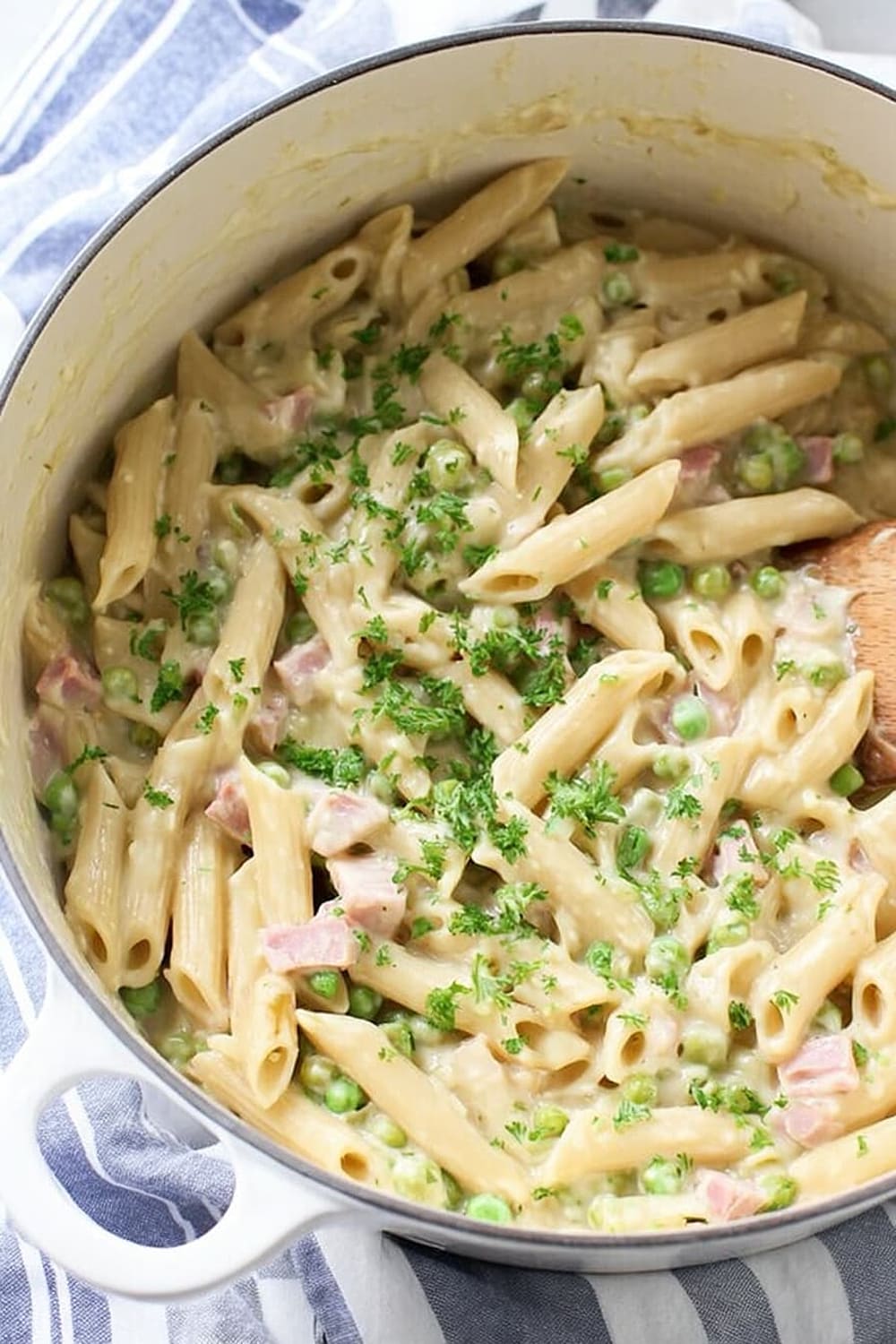
This recipe is basically the superhero of weeknight dinners – it swoops in to save the day when you’re staring at leftover ham and wondering what magic you can possibly create.
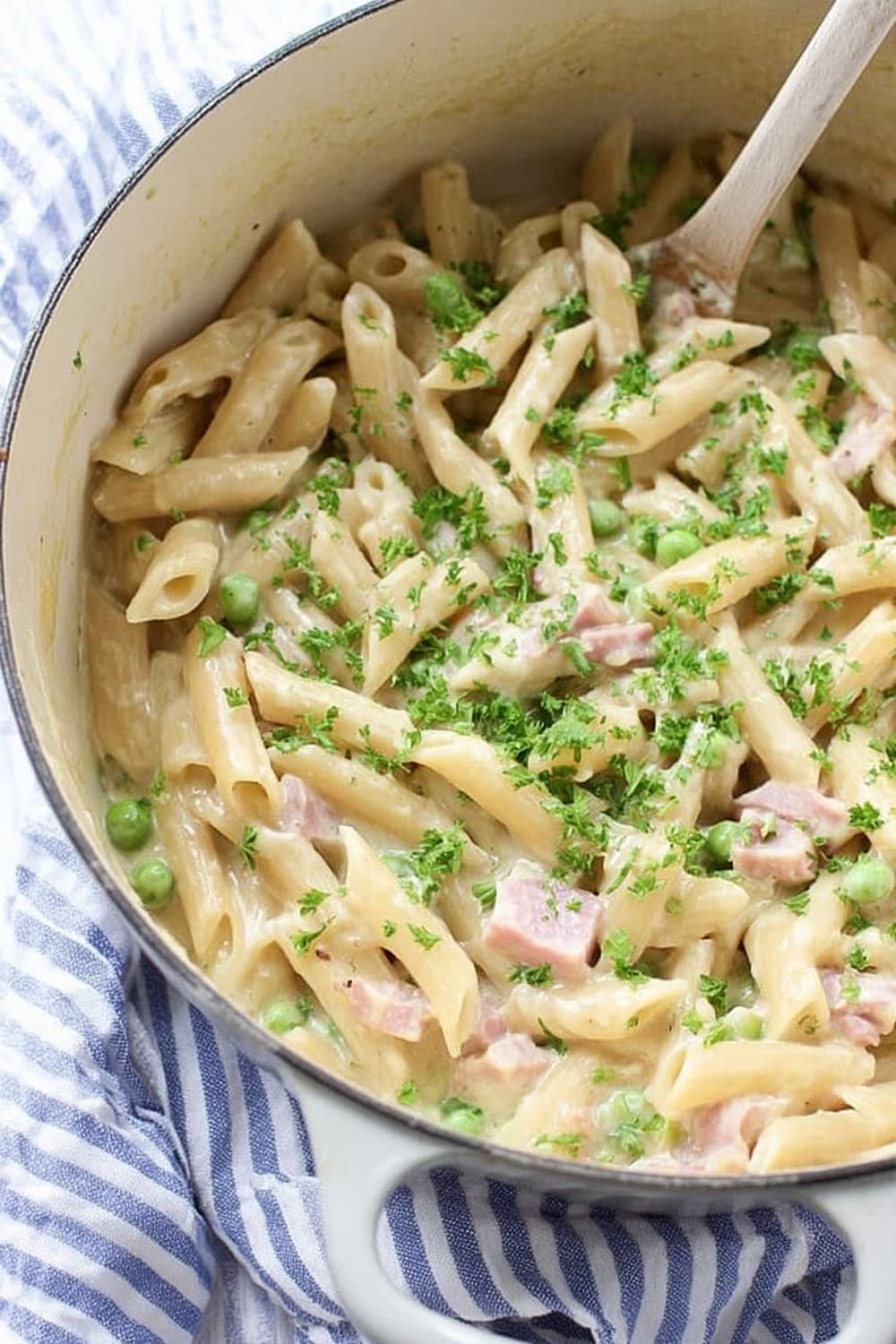
One pot means one cleanup session, which automatically makes this recipe worth its weight in gold, especially when that pot transforms into a creamy, cheesy masterpiece that’ll have everyone asking for seconds.
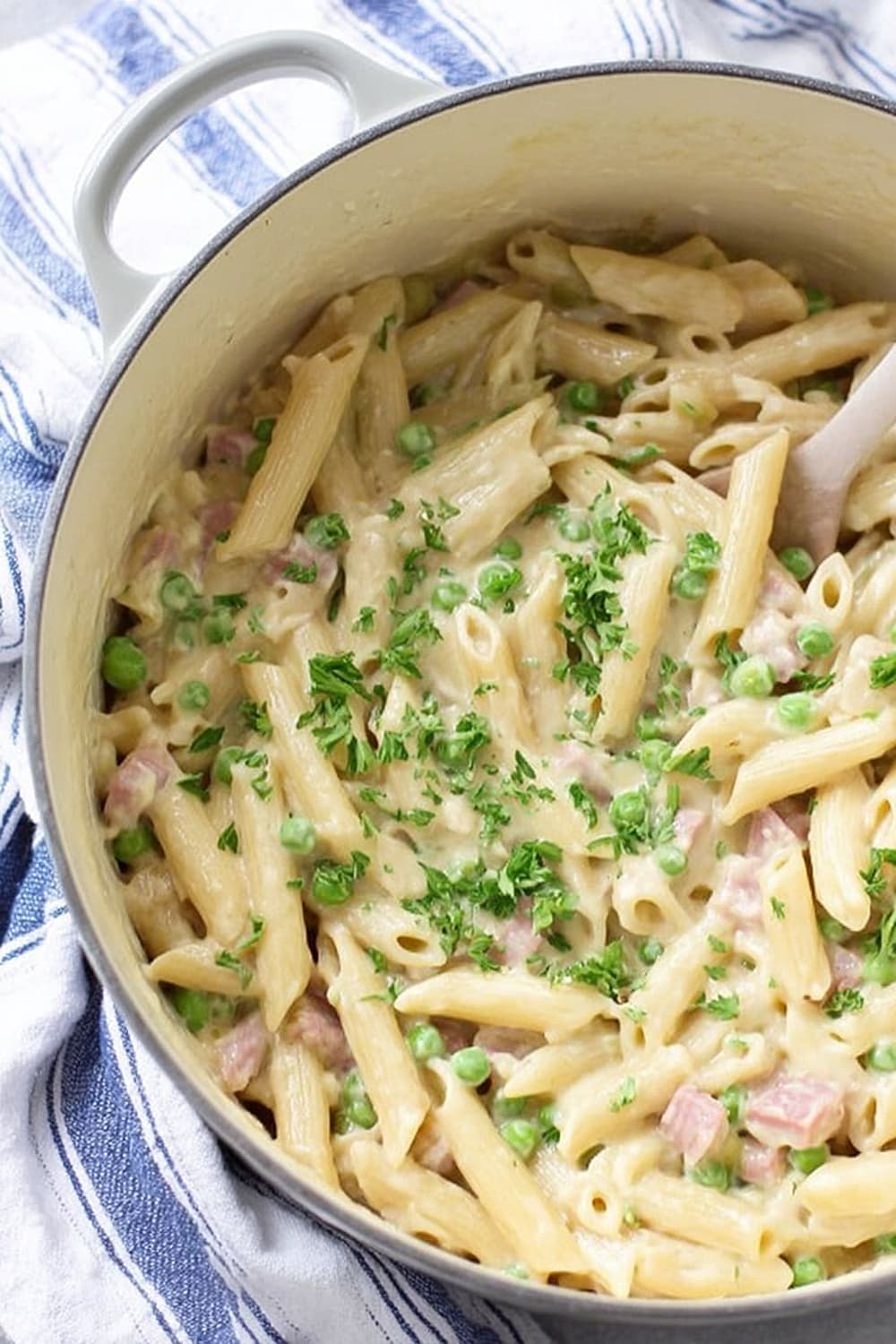
The combination of tender leeks, salty ham, and bright green peas creates a symphony of flavors that tastes like you spent hours in the kitchen, but really you just threw everything into one pot and let it work its magic.
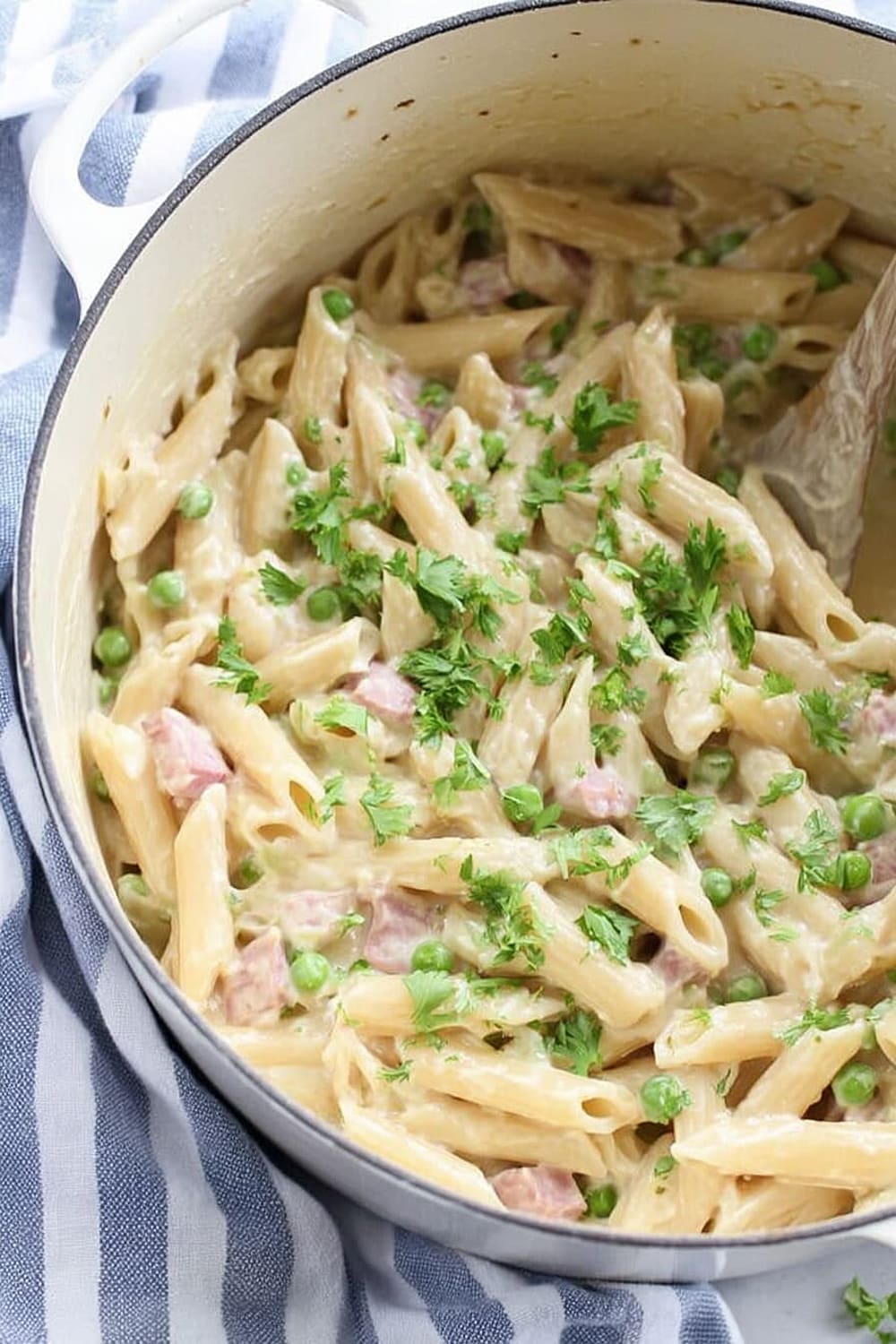
That melted Gruyere cheese doesn’t just add flavor – it creates a luxurious sauce that coats every piece of pasta, making each bite absolutely irresistible.
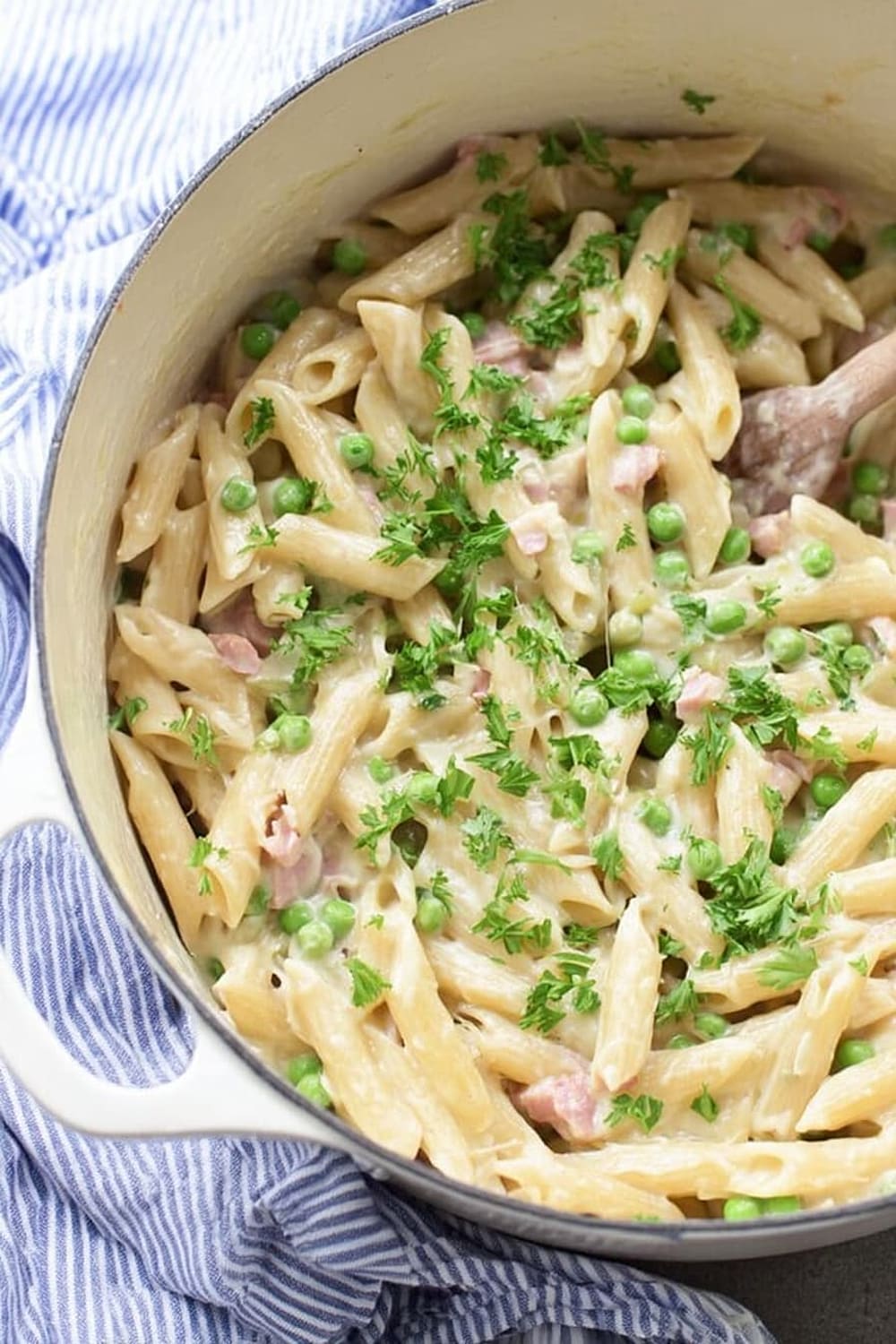
Using ham poaching liquid instead of plain water is like having a secret ingredient that adds depth and richness you simply can’t get any other way.
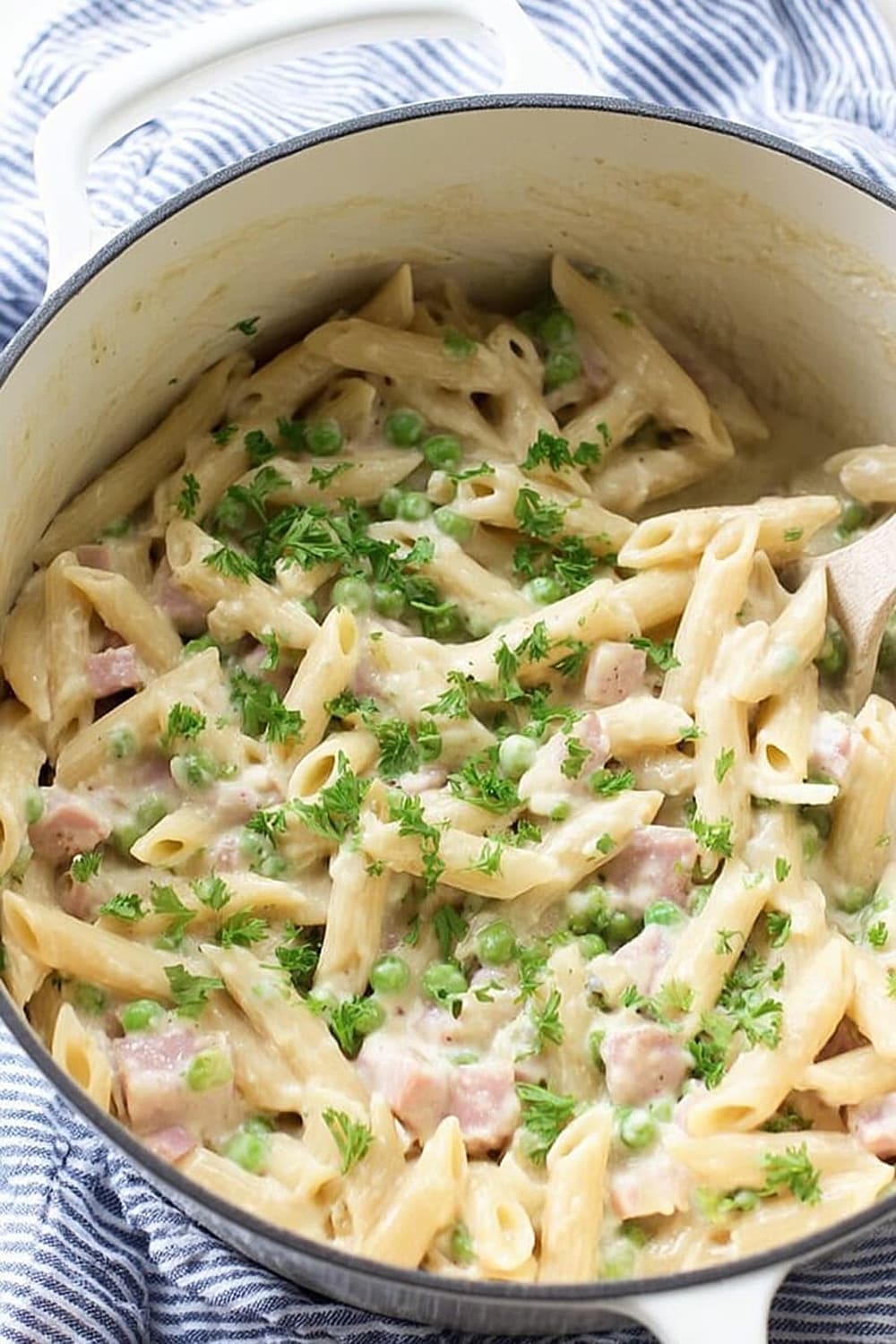
This is comfort food at its finest – the kind of meal that makes you feel like you’ve got your life together, even if you’re just trying to use up leftovers before they go bad.
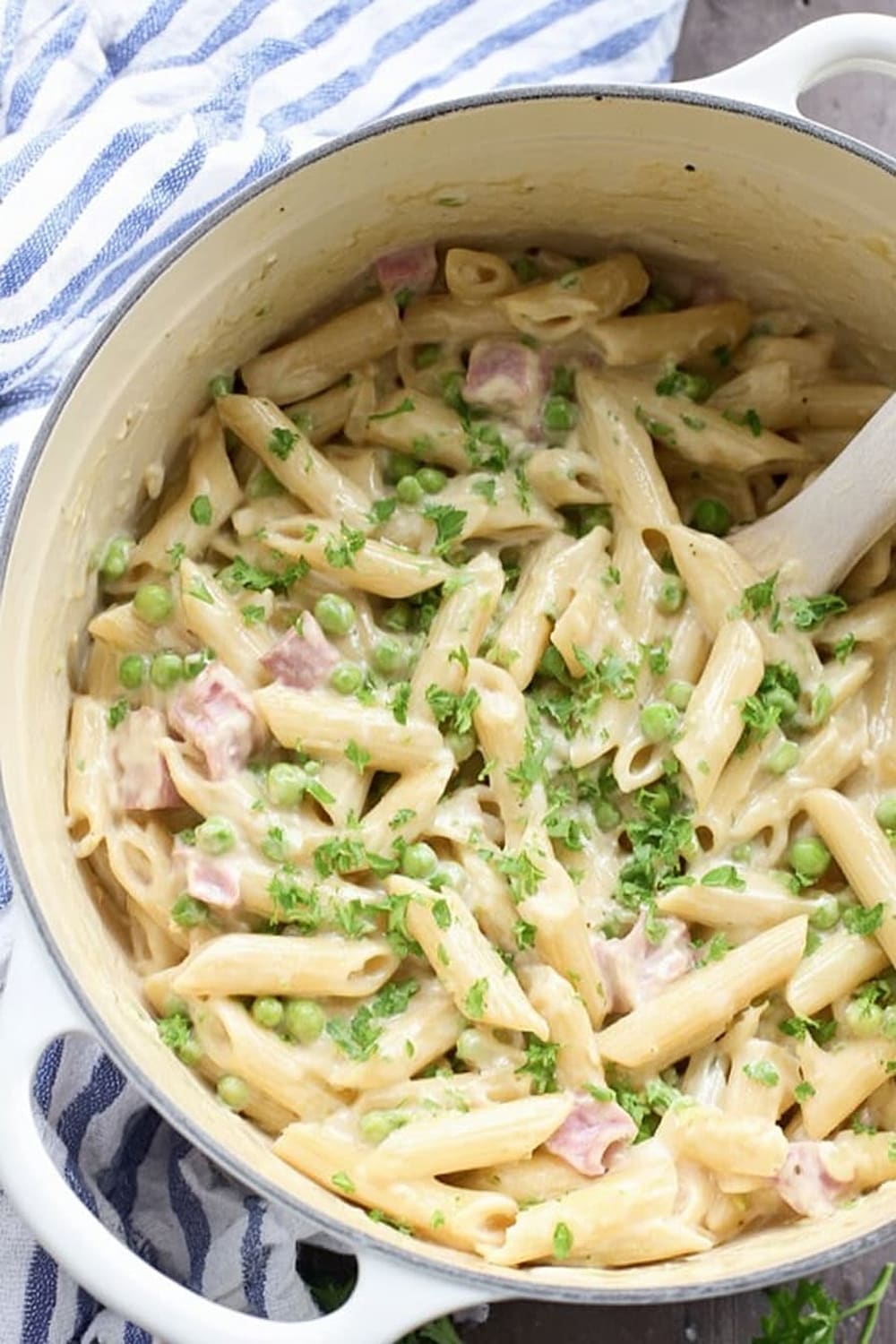
Ingredients
For the pasta base
- 350 g wholewheat penne pasta (or any pasta shape you prefer)
- 1 liter water or ham poaching liquid
- 1 tablespoon Dijon mustard
For the aromatic foundation
- 1 large leek (white and light green parts only), cleaned and thinly sliced
- 2 large garlic cloves, finely chopped or minced
- 25 g unsalted butter
For the protein and vegetables
- 250-300 g leftover ham or gammon, roughly chopped into cubes
- 200 g frozen peas
- 170-200 g Gruyere cheese, freshly grated
For serving (optional)
- Fresh parmesan cheese, grated
- Fresh parsley, chopped
- Freshly ground black pepper
Instructions
Prepare the vegetables
- 1 Prepare the leek by cutting it in half lengthwise and running it under cold tap water. Separate the layers just enough to wash out any grit, but keep the leek structure intact. Once completely clean, slice each half into thin, uniform pieces about ¼-inch thick. This ensures even cooking and prevents any bitter, undercooked pieces.
- 2 Melt the 25g butter in a large, heavy-bottomed casserole pot over medium heat until it begins to foam. Add the sliced leeks and cook gently for 8-10 minutes, stirring frequently to prevent browning. The leeks should become soft and translucent but retain their bright color – this creates the sweet, aromatic base that makes this dish so special.
- 3 Add the chopped garlic and continue cooking for 1-2 minutes more, stirring constantly to prevent burning. You’ll know it’s ready when the garlic becomes fragrant and just begins to soften – this timing is crucial because burnt garlic will make the entire dish bitter.
Build the pasta base
- 4 Add the pasta and cubed ham to the pot, followed immediately by the ham poaching liquid or water and 1 tablespoon Dijon mustard. Season generously with salt and freshly ground black pepper, keeping in mind that the ham will add saltiness as it cooks. The mustard adds a subtle tang that balances the richness of the cheese and ham.
- 5 Give everything a thorough stir to ensure the pasta is evenly distributed and the mustard is completely incorporated. Increase the heat to high and bring the mixture to a rolling boil – this should take about 3-4 minutes depending on your stove’s power.
Cook the pasta
- 6 Once boiling, immediately cover the pot with a tight-fitting lid, reduce the heat to medium-low, and simmer gently for 12 minutes. Resist the urge to lift the lid during this time, as the steam is essential for cooking the pasta evenly. The liquid should be barely bubbling around the edges.
Finish the dish
- 7 Remove the lid and give the pasta a good stir – it will look quite saucy at this point, which is exactly what you want. Add the frozen peas and cook for 2-3 minutes until they’re heated through and bright green. The residual heat will cook them perfectly without making them mushy.
- 8 Remove the pot from heat and immediately add the grated Gruyere cheese, mixing vigorously until it melts completely and creates a creamy sauce that coats every piece of pasta. The cheese should melt smoothly – if it seems to seize, add a splash of the cooking liquid to bring it back together.
- 9 Serve immediately in warmed bowls, topped with additional grated parmesan if desired and a generous sprinkle of fresh chopped parsley for color and freshness.
Recommended Equipment and Kitchen Tools
Essential Tools (for best results)
- Large casserole pot or Dutch oven – A heavy-bottomed pot distributes heat evenly and prevents the pasta from sticking or burning during the simmering process
- Sharp chef’s knife – Essential for properly cleaning and slicing the leeks, which can be tricky with a dull blade
- Wooden spoon or silicone spatula – Won’t scratch your pot’s surface and provides the best control when stirring the delicate cheese sauce
- Microplane grater – Freshly grated Gruyere melts much more smoothly than pre-shredded cheese and creates a superior sauce
Helpful Upgrades
- Kitchen scale – Measuring pasta and cheese by weight ensures consistent results every time, especially important for the cheese-to-pasta ratio
- Instant-read thermometer – While not essential, it helps ensure your cooking liquid maintains the proper gentle simmer temperature
- Fine-mesh strainer – Useful for cleaning leeks thoroughly, ensuring no grit makes it into your finished dish
Nice-to-Have Options
- Cheese storage containers – Proper storage keeps your Gruyere fresh and prevents it from drying out
- Pasta serving bowls – Warmed bowls keep this dish at the perfect temperature for serving and enhance the overall dining experience
Recipe Variations and Dietary Modifications
Gluten-Free Adaptation
- Replace wholewheat penne with 350g gluten-free pasta (rice-based works exceptionally well)
- Increase cooking liquid by 200ml as gluten-free pasta tends to absorb more liquid
- Reduce cooking time to 10 minutes and check frequently, as gluten-free pasta can become mushy quickly
- Add pasta gradually to prevent clumping
Dairy-Free Modifications
- Substitute butter with 2 tablespoons olive oil or vegan butter alternative
- Replace Gruyere with 170g nutritional yeast mixed with 2 tablespoons cashew cream for richness
- Use plant-based milk if additional liquid is needed for creaminess
- Omit optional parmesan or use dairy-free alternative
Vegetarian Version
- Replace ham with 300g roasted mushrooms (portobello or shiitake work beautifully)
- Use vegetable stock instead of ham poaching liquid
- Add 1 tablespoon soy sauce for umami depth
- Include 2 tablespoons toasted pine nuts for additional protein and texture
Low-Carb Adaptation
- Substitute pasta with 500g spiralized zucchini or shirataki noodles
- Reduce cooking time to 5 minutes to prevent vegetables from becoming mushy
- Increase cheese quantity to 250g to maintain richness
- Add 100g cauliflower florets for additional bulk and nutrition
Flavor Variations
- Mediterranean twist: Add sun-dried tomatoes, olives, and fresh basil
- Spring version: Include asparagus spears and fresh herbs like chives or dill
- Smoky variation: Use smoked paprika and add roasted red peppers
- Spicy kick: Include red pepper flakes and finish with hot sauce
Nutritional Information and Health Benefits
Key Nutritional Highlights
This hearty one-pot meal provides approximately 454 calories per serving, making it a substantial yet reasonable dinner option. The combination of wholewheat pasta, lean ham protein, and vegetables creates a well-balanced macronutrient profile with roughly 22g protein, 58g carbohydrates, and 14g fat per serving. The wholewheat pasta contributes significant fiber content, helping you feel satisfied longer while supporting digestive health.
Health Benefits of Main Ingredients
The leeks in this recipe are nutritional powerhouses, providing substantial amounts of vitamin K for bone health and folate for cellular function. Ham supplies high-quality complete protein along with B-vitamins, particularly B12 and niacin, which support energy metabolism and nervous system function. Green peas contribute plant-based protein, fiber, and antioxidants like lutein and zeaxanthin that support eye health. Gruyere cheese provides calcium for bone strength and conjugated linoleic acid, which may have anti-inflammatory properties.
Dietary Considerations
This recipe contains gluten from wheat pasta and dairy from cheese and butter, making it unsuitable for those with celiac disease or dairy allergies without modifications. The sodium content is moderate due to the ham and cheese, so those monitoring sodium intake should consider portion sizes. The dish provides a good balance of complex carbohydrates from wholewheat pasta and quality protein from ham and cheese, making it suitable for active individuals and growing families.
Smart Swaps and Ingredient Substitutions
Common Substitutions:
- Gruyere cheese → Swiss cheese, sharp cheddar, or aged gouda (use same amount)
- Leeks → 1 large yellow onion, sliced thin, or 4 shallots, minced
- Leftover ham → Cooked bacon pieces, pancetta, or rotisserie chicken
- Frozen peas → Fresh peas, edamame, or green beans cut into 1-inch pieces
- Dijon mustard → Whole grain mustard or 1 teaspoon dry mustard powder
Budget-Friendly Swaps:
- Gruyere cheese → Sharp cheddar or aged white cheddar (costs about 60% less)
- Ham poaching liquid → Chicken or vegetable stock with 1 teaspoon soy sauce
- Fresh leeks → Frozen leeks (thawed and drained) or yellow onions
- Wholewheat pasta → Regular pasta shapes from bulk bins
Pantry Emergency Substitutions:
- Fresh garlic → 1 teaspoon garlic powder (add with the pasta)
- Butter → Olive oil or vegetable oil (use 2 tablespoons)
- Ham → Canned ham, diced (drain and rinse first)
- Fresh parsley → Dried parsley, chives, or Italian seasoning
Pro Tips for Substitutions:
- When using different cheeses, grate them fresh for better melting
- If using fresh peas instead of frozen, blanch them first for 2 minutes
- Store leftover grated cheese in airtight containers for up to one week
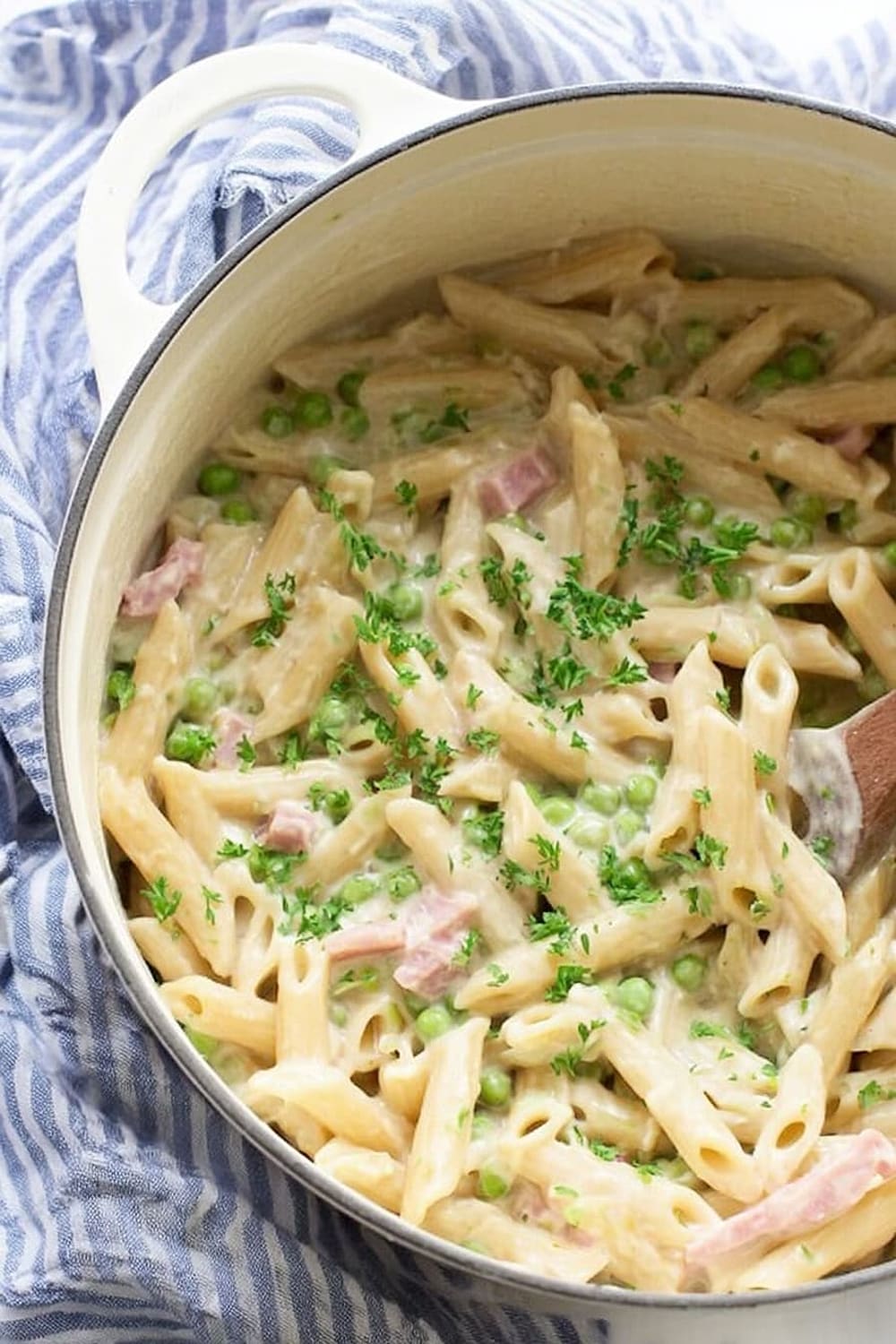
Make It Diabetes-Friendly
Carb Reduction Strategies:
- Replace 350g regular pasta with 200g shirataki noodles mixed with 150g spiralized zucchini
- Use 250g cauliflower florets instead of pasta for a low-carb version
- Reduce pasta portion to 200g and add 200g roasted vegetables like bell peppers and zucchini
- Total carb reduction: From 58g to approximately 25g per serving
Portion & Timing Tips:
- Serve ¾ cup portions instead of full cups to reduce carb load
- Pair with a large green salad to increase fiber and slow glucose absorption
- Add 2 tablespoons chopped walnuts for healthy fats and protein
- Estimated carbs per modified serving: 25-30g depending on substitutions chosen
Blood Sugar Management:
- Include 1 cup steamed broccoli or green beans alongside each serving
- Start the meal with a small salad dressed with olive oil and vinegar
- Choose whole grain pasta alternatives like lentil or chickpea pasta for added protein and fiber
- Monitor portion sizes and consider this as your main carbohydrate for the meal
Glycemic Impact Improvements:
- Add 1 tablespoon apple cider vinegar to the cooking liquid to help moderate blood sugar response
- Include 2 tablespoons ground flaxseed for additional fiber and omega-3 fatty acids
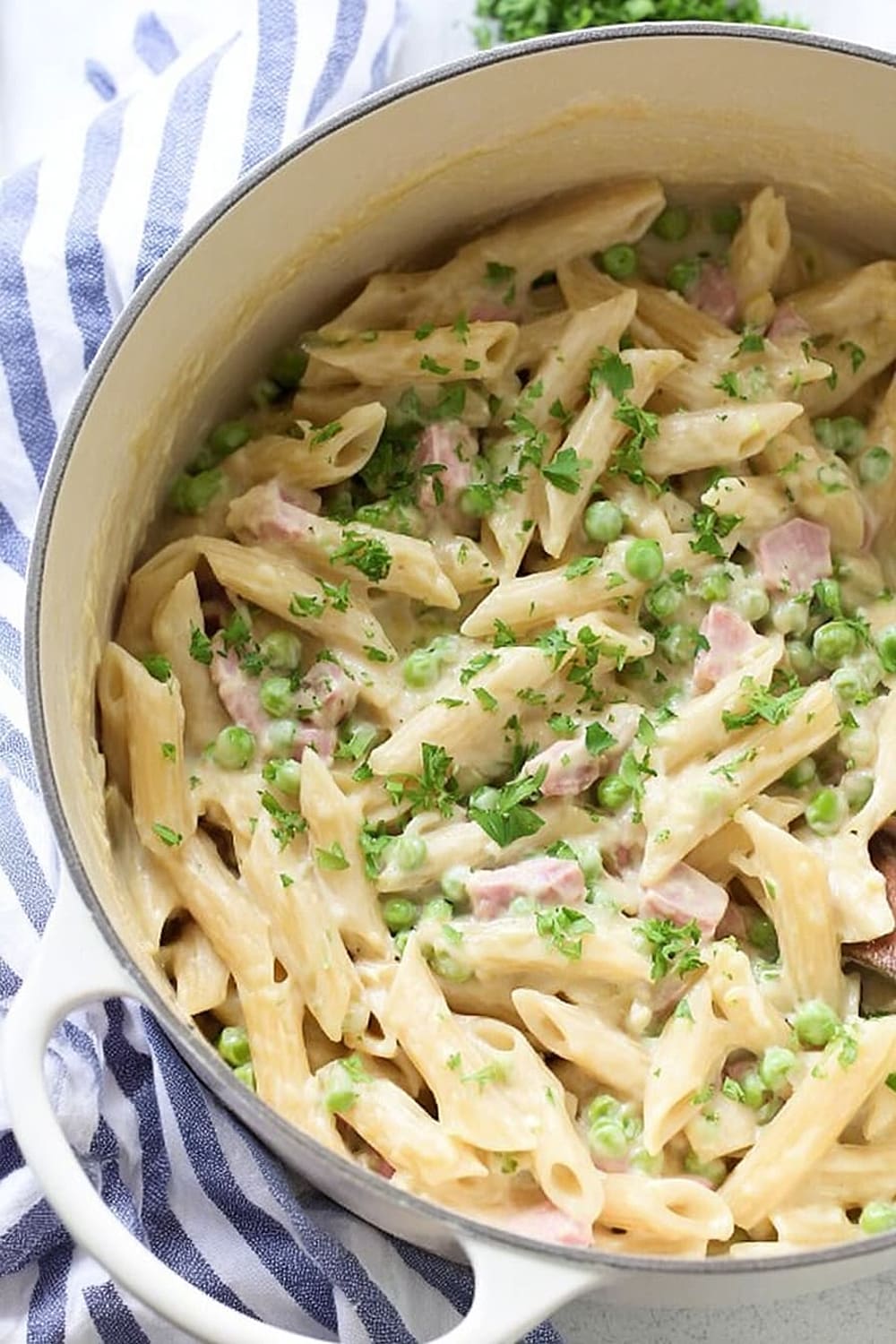
Perfect Pairing Suggestions
Beverage Pairings
A crisp white wine like Sauvignon Blanc or Pinot Grigio complements the creamy cheese sauce while cutting through the richness of the ham. For beer lovers, a light lager or wheat beer provides a refreshing contrast to the hearty pasta. Non-alcoholic options include sparkling water with lemon, unsweetened iced tea, or a light cucumber-mint infused water that cleanses the palate between bites.
Side Dish Recommendations
A simple arugula salad with lemon vinaigrette provides peppery contrast to the rich, creamy pasta, while roasted asparagus or green beans add fresh vegetable elements that complement the peas in the dish. Garlic bread or crusty sourdough rolls are perfect for soaking up any remaining sauce, and a light coleslaw adds crunch and acidity that balances the meal’s richness.
Complete Meal Ideas
Start with a light soup like butternut squash or tomato basil, serve the pasta as your main course, and finish with a fresh fruit salad or lemon sorbet to cleanse the palate. For entertaining, add a cheese and charcuterie board as an appetizer, and consider serving the pasta family-style with multiple side dishes for a more casual, communal dining experience.
Occasion Suggestions
This recipe is perfect for casual weeknight dinners, Sunday family meals, or potluck gatherings where you need something hearty and crowd-pleasing. It’s also excellent for using up holiday ham leftovers, making it ideal for post-Easter or post-Christmas meals when you want something comforting but different from the original feast.
Pro Tips and Troubleshooting
Professional Cooking Tips
Always clean leeks thoroughly by slicing them first, then soaking in cold water for 10 minutes to remove all grit – dirty leeks will ruin the entire dish. Save ham poaching liquid in the freezer for up to 3 months; it adds incredible depth to soups, stews, and pasta dishes like this one. Grate Gruyere cheese fresh rather than buying pre-shredded, as fresh cheese melts more smoothly and creates a better sauce consistency.
Common Mistakes and Solutions
If your cheese sauce becomes grainy or separates, remove the pot from heat immediately and whisk in 2-3 tablespoons of the hot cooking liquid until smooth. Overcooked pasta is the most common issue – set a timer and check at 10 minutes, as different pasta shapes cook at different rates. If the dish seems too dry, add hot cooking liquid gradually until you reach the desired consistency.
Storage and Reheating
Store leftovers in the refrigerator for up to 3 days in airtight containers. When reheating, add 2-3 tablespoons of milk or stock to restore creaminess, and reheat gently over medium-low heat, stirring frequently. This dish doesn’t freeze well due to the dairy content, but it makes excellent next-day lunches when reheated properly.
Make-Ahead Strategies
Prepare the leek and garlic mixture up to 2 days ahead and store covered in the refrigerator. Cube the ham and grate the cheese the morning of cooking. The complete dish is best made fresh, but you can prep all ingredients in advance for quick assembly during busy weeknights.
This one-pot wonder proves that the best comfort food doesn’t require complicated techniques or hours of preparation – just quality ingredients, proper timing, and the confidence to let simple flavors shine together in perfect harmony.